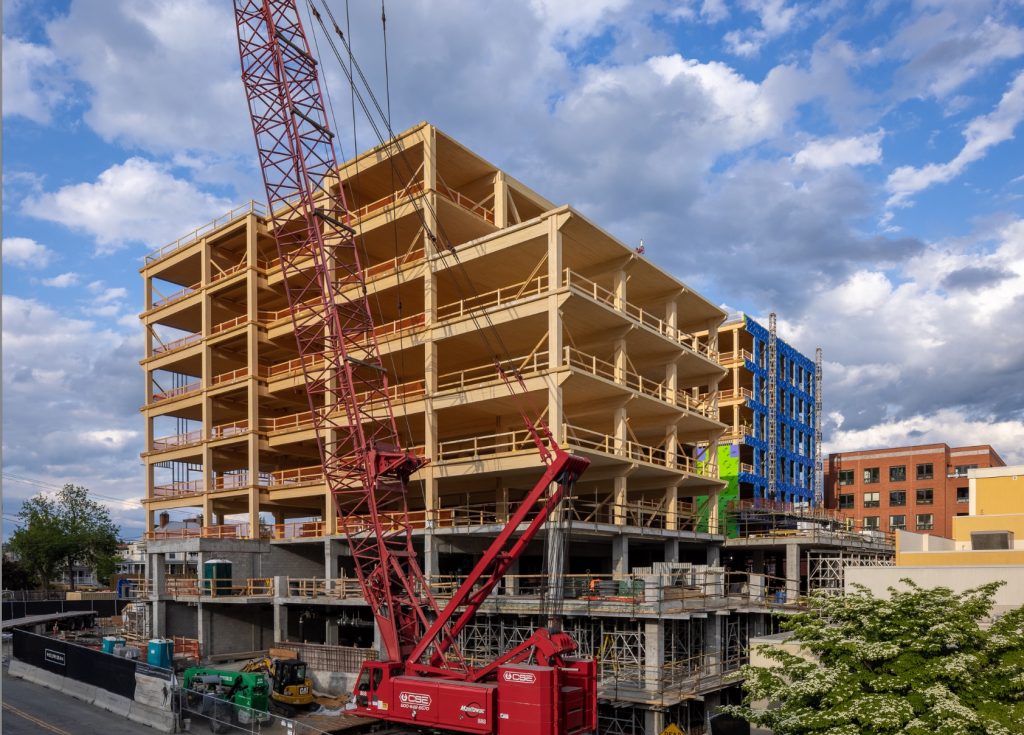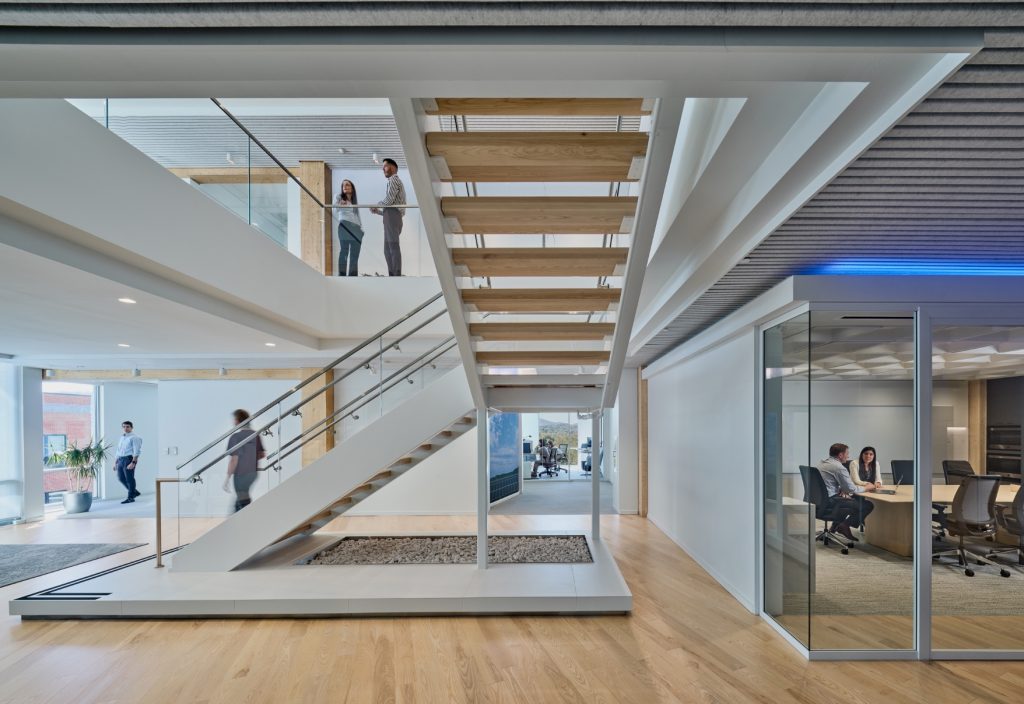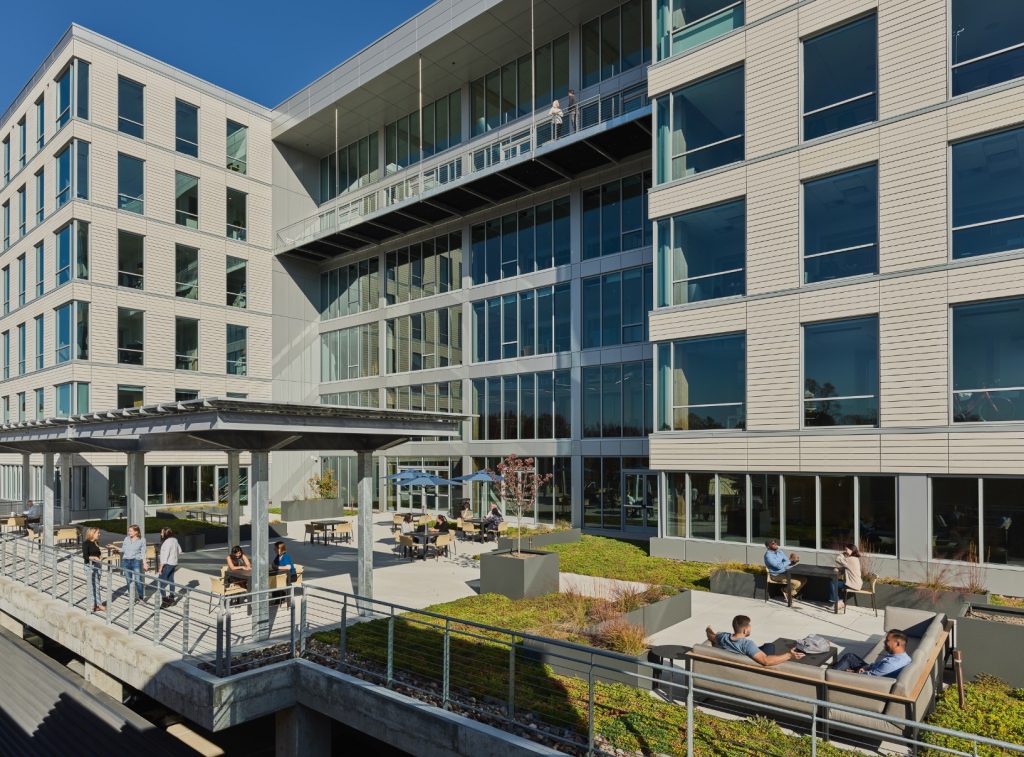Apex Clean Energy’s headquarters tells two stories. It’s a mass timber anchor for Charlottesville’s future in net-positive energy and it’s a beacon for a design firm’s legacy at sustainability’s vanguard. The firm, of course, is William McDonough + Partners (WM+P), which celebrates 30 years in Charlottesville next year. In that time, it has also helped a lot of corporate clients and has made an incalculable impact on the physical footprints and ethical imperatives of the international corpocracy whose influence is great, but whose responsibility—many feel—is greater. WM+P has also invested a lot in research outside of client development to maintain its leadership in advancing the circular economy, decarbonization, or material science. So, when Apex approached the firm in 2017, it wasn’t much of a stretch for a clean energy company to sign on for a 187,000 square-foot net-positive cross-laminated timber building—especially since it meant improving an unloved piece of blacktop on the south side of town near the train tracks. WM+P principal and Design Partner, Alastair Reilly, AIA (whose portfolio includes NASA’s Sustainability Base, YouTube’s headquarters, and Park 20-20 outside of Amsterdam) reports it was a great partnership from the beginning. “With Apex, we always wanted to go beyond business as usual—and so one goal was to reduce the weight of the building by reducing the amount of concrete. Of course, a mass timber structure reduces a lot of weight, so it seemed like the right solution for that and a lot of other reasons, too,” he says. “Despite the additional cost associated with engineered wood in a tenant/owner-driven building on a developer’s budget, we firmly believe it has paid off. We view this as an undeniable, no-brainer idea. It begs the question: Why aren’t more people doing this?”
What was the brief from the client?
Apex came to us in 2017 as a renewable energy start-up and they’ve grown to more than 200 employees—but they were spread out in three different buildings downtown in Charlottesville. Our initial goal was to help consolidate their operations into a single location near downtown with convenient walkability. At that time, there wasn’t much Class A office space in Charlottesville, and now there are three similar buildings in the area. Regardless, ACAC Health and Wellness, and Riverbend Development were the owners of the existing parking lot site, and partnered with Apex to develop their new offices. We’d just come off a mass timber project in Northern Virginia for HITT Contracting, a research and collaboration space, so in our initial meetings with Apex, our goal was not only to achieve net-zero energy consumption but also to surpass it and incorporate the use of mass timber. We had previously worked with Walmart on their headquarters campus, where we gained valuable experience in implementing mass timber construction.



McDonough, as a firm, has been around long enough to have seen mass timber’s fullest historical trajectory, and all of the hurdles it has cleared. But the firm has also long talked about trees as metaphors for buildings. How does the firm’s philosophy map onto mass timber’s future?
As you say, we have a long history of thinking that way. Our [Adam Joseph Lewis] Center for Environmental Studies at Oberlin College was constructed using glued-laminated timber, or glulam, which we would refer to as heavy timber—and that was 25 years ago—taking into consideration the carbon impact of the wood. It was one of the first Net-Zero Verified buildings and predated LEED. The big thing we’re seeing with the commercialization with cross-laminated timber, or CLT, is the change in the manufacturing process. Instead of seeking the largest old-growth trees, we now prioritize fast-growing timber to produce a technical product from a natural source—taking something natural and adding glue to create a valuable asset. This pertains to the embodied carbon aspect. On the operational carbon side, another crucial aspect of working with Apex, is their deep concern for operational carbon. Right now, the PVs cover 25% of the building’s energy needs, resulting in a 70% improvement in efficiency compared to a baseline building.
One of the Cradle-to-Cradle dimensions of this project is the possibility of disassembly and reuse later. How will those upstream decisions make a difference later?
This aspect is of utmost importance, and wood offers a distinct advantage—it is inherently designed for disassembly. We spend a lot of time thinking about the future, creating commercial buildings that can be easily adapted to residential housing which is needed now more than ever. Designing for next use is about extending the use period. In the long term, if disassembled, it becomes a valuable material asset—we refer to it as “buildings as material banks.” The beams retain their structural integrity, just like steel, and consequently hold value in the marketplace. Our focus is on designing for long-term flexibility. Systems can be adapted and upgraded. The building’s skin can be improved. The windows can be upgraded.
One of the advantages of prefabricated CLT panels, as Apex has, is the ability to assemble them quickly on site, which reduces the overall construction time. As easy as that sounds, did you encounter any challenges you weren’t expecting?
We underwent construction during a very wet winter cycle. We initially built half of the podium vertically on the east side, and then proceeded to construct the remaining podium on the west side. Despite these circumstances we managed to achieve zero waste on-site and did not require staging. Trucks arrived with panels and delivered them directly to the appropriate floor, resulting in a 50% reduction in crew needed for installation. Also, this resulted in less construction traffic for the neighborhood.
In its modules and predictable forms, low-rise mass timber buildings are usually overlooked from a design perspective. What does design mean for a delivery system and structural system that is so prescriptive?
We are currently working on a multi-family mass timber project in Charlotte and there’s a transition, as you say, when it comes to design. In Europe, there is a prevalence of module-based and box-like designs for non-residential projects. However, in the United States, we are witnessing greater flexibility and creativity in this regard. For instance in California, we’re designing YouTube’s headquarters , a new CLT building that echoes the coastal savannah ecosystem. On the residential side, I am seeing a surge of creativity in multi-family projects, much like the innovative use of CLT seen in single-family homes in Maine and New England, inspired by the European model. While cost isn’t as much of a premium these days in the design phase, the pre-engineering aspects still entail substantial upfront work and cost.
Having Apex as a client, who expressed their desire for a building that goes beyond an all-glass design, has been fantastic. William McDonough has consistently emphasized the importance of building like a tree, even going so far as to say we must be like a tree—creating fuel, purifying water, and providing a habitat. I believe that is the purpose of architecture, and it is certainly what we strive to achieve.
This interview has been edited for clarity and length.
William Richards is a writer and the Editorial Director of Team Three, an editorial and creative consultancy based in Washington, DC.
Project credits: Apex Clean Energy Headquarters
Architect: William McDonough + Partners
MEP engineers: Staengl Engineers
Structural engineers: Simpson Gumpertz & Heger, Structural Engineers
Civil engineers: Collins-Engineering
Mass timber fire engineering consultant: ARUP
Contractor: Hourigan
Interior architects for Apex Clean Energy office space: FORM Architects
